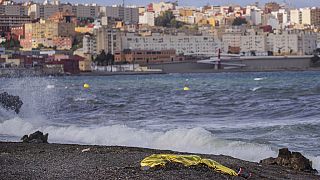Rijksmuseum
The new exhibition called "Remember Me" at the Rijksmuseum offers a snapshot of European society in the Renaissance period.
It includes for the first time in a single exhibition the two earliest individual portraits of Black men known in Europe.
One is a painting by Jan Jansz Mostaert of a man in military attire. He's thought to have been Christophle le More, a personal bodyguard to Holy Roman Emperor Charles V.
Another chalk drawing from 1508 is "Portrait of an African Man," by Albrecht Duerer, on loan from Vienna's Albertina Collection.
The museum's General Director Taco Dibbits believes it was vital to bring Europe's Black population out of obscurity and acknowledge slavery meant that Africans were very present in the fifteenth century.
Dibbits explains: Well, I think that there was a presence in the Renaissance, so around 1500 of Africans in Europe and we felt it very important to show these two works, to also show that presence. I think that for a long time in the history of art, these works were invisible. So people just thought, well they didn't exist. But there was a presence of African men and women."
As COVID-19 lockdowns ease and borders reopen people are happy to gather again at Amsterdam's Rijksmuseum.
There are 100 Renaissance portraits of people from around Europe all part of the exhibition "Remember Me".
It covers the period between 1470-1570 and features portraits by masters including Albrecht Duerer, Hans Holbein and Titian.
They were curated to underscore the theme of humanity's enduring desire to be remembered.
It shows the lengths artists went to portray people, their wealth, jobs, power and love for one another.
While the exhibition has been in the works since before the global pandemic swept the world last year, the wish to be remembered is something that felt more pressing than ever amid lockdowns, says Dibbits.
"We now felt with the corona crisis that people were so far away they couldn't come to you. You couldn't travel," Dibbits says.
"That was always the case in the Renaissance when it was far harder to travel and there was this great longing to have the person with you. I think something that we felt over the last one-and-a-half years."
For Dibbits and Matthias Ubl, the museum's curator of Early Netherlandish, Italian and German painting, one of the standout highlights of the show is the enigmatic "Portrait of a Young Girl," painted around 1470 by Petrus Christus.
The portrait of an unknown girl is on loan from the Gemaeldegalerie in Berlin. It's the first time the painting has left the museum since 1994.
Ubl says he first became fascinated by the work when he saw it on a poster as a student in London some 20 years ago.
"When I first saw it, I thought, wow, this is just so amazing. This is one of the most beautiful portraits there is. And now it's here and it's almost unreal."
Getting all the loaned portraits to Amsterdam from museums around Europe and United States was a feat in itself at a time of travel restrictions.
"We're incredibly grateful that we got them all together," Dibbits says.
"And it's really like a (re)union, you could say. It was like real people now get back together again and also these people from the Renaissance have gathered again together."
"Remember Me" opens October 1 and runs to January 16, 2022.













01:30
UN reports widening global inequality in sexual and reproductive health and rights
01:11
UK man runs the length of Africa in 10,000 miles and 352 days
00:59
British man running length of Africa nears finish line
00:47
We are working on ways to support drought-hit African countries- IMF
01:35
Morocco: Rabab Cheddar chases Olympic dreams while fasting Ramadan
01:58
Putin addresses French president's concerns over Russian presence in Africa